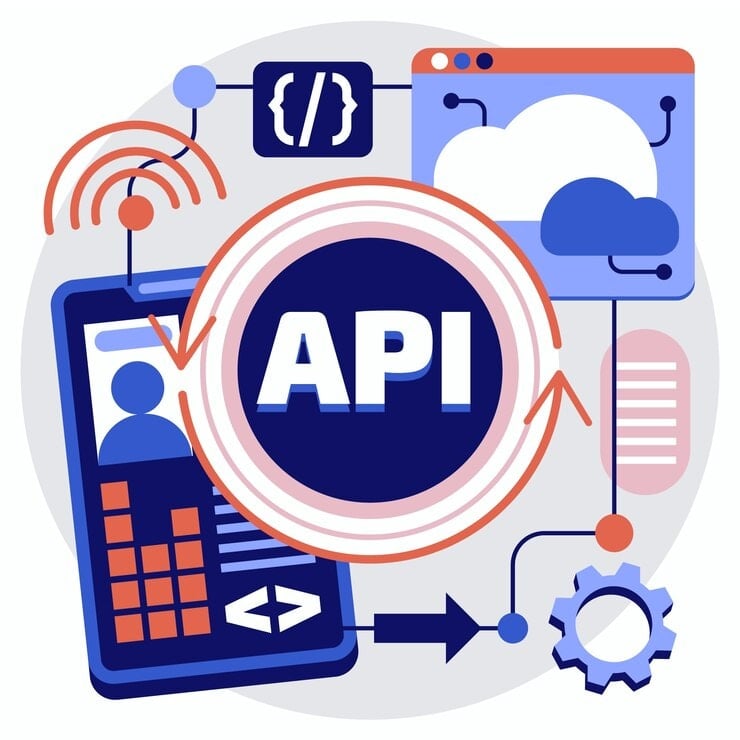Online payments used to be complex, and filled with errors, and often failed payments caused customers to leave their shopping carts. A business owner in Texas lost $50,000 in sales last month because their payment system failed. Using modern payment APIs, their competitor processed $200,000 without a glitch.
The difference? Payment APIs – the digital bridges that connect your business to the global financial network. In 2025, these APIs will do more than just process transactions. They’re changing how businesses operate, from small Etsy shops to large enterprises.
Think about this: Every time a customer clicks “pay now,” about 20 different processes happen in less than 2 seconds. Payment APIs handle all of them automatically. They verify cards, collect payments, check for fraud, convert currencies, and send confirmation emails – tasks that would take a human several minutes to complete.
But here’s what most businesses don’t know: Integrating with payment gateway and APIs isn’t just about accepting money. It’s about getting data that helps you understand your customers better, reduce fraud, and make smarter business decisions.
The best part? You don’t need to be a tech expert. Modern payment APIs come with tools that make integration simple. This guide will show you exactly how payment gateway and APIs work, which ones to choose, and how to integrate them into your business.
Save 80% of delivery management time
We handle everything:
- Dedicated operations manager
- Real-time tracking dashboard
- Automated customer notifications
- Urgent issue resolution
What is Payment API integration?
Payment APIs simplify processing online payments.
Enables accepting credit cards and digital wallets.
Connects businesses directly or via third parties.
Definition of Payment APIs
Payment APIs are tools that help businesses handle online transactions. They act as a middleman, making it easy for a business to accept money from customers through various methods like credit cards, bank transfers, and digital wallets. These APIs help businesses streamline their payment processing, so they don’t need to build and maintain their payment systems.
When we talk about “API” in this context, it means “Application Programming Interface.” An API allows different software to communicate with each other. Payment APIs let a business’s website or app talk to payment processing servers. By using payment APIs, companies can manage transactions, process refunds, and even set up recurring payments.
There’s a common question: “What is an API in payments?” Simply put, it’s a tool that makes it easy for your online platform to talk to financial institutions and process payments. Payment gateway and APIs eliminate complexity in handling multiple payment gateway methods in multiple currencies and ensure secure transactions.
Example(s) of Payment API integration
Integrating payment APIs can mean connecting your online store and payment links with Stripe or PayPal. Stripe’s API lets users complete their purchases without leaving your website, providing a smooth checkout experience. This reduces drop-offs during the final stages of purchasing, improving conversion rates.
Using PayPal’s various payment API options brings another layer of convenience. It enables customers to use stored payment details for a quicker transaction process. You might wonder, “How to integrate payment API?” Most provide comprehensive documentation and support. They offer examples and tools to help developers add these APIs to a website or app.
A common usage scenario is an e-commerce merchant or site offering both Stripe and PayPal. This allows customers flexibility in payment options, which can lead to increased sales. According to PayPal, businesses see up to a 44% increase in checkout conversion rates when using PayPal Express Checkout.
Types of Payment APIs
Payment APIs can be grouped into two main types: direct and aggregator. An important feature that many businesses are leveraging is recurring billing, which automates subscription payments and helps in growing consistent revenue streams. By integrating payment APIs that support automated recurring billing, businesses can reduce manual processing, minimize missed payments, and enhance customer retention. For an in-depth look at how recurring billing transforms payment handling, check out this guide on effective recurring billing solutions.
Direct payment APIs
Direct payment APIs allow a business to communicate directly with banks or card networks for processing payments. They are suitable for large companies with the resources to manage complex integrations. A direct payment API often requires PCI compliance, a set of security standards that protect card information during transactions.
Working with direct payment APIs can give more control over payment processes. Businesses can customize the user experience more than with an aggregator. However, it also involves more responsibility, as managing payment data comes with strict legal compliance.
Aggregator payment APIs
Aggregator payment APIs simplify the process of subscription payments. They handle payments through third parties, which means the business doesn’t interact directly with the banks. Examples include PayPal and Stripe. These APIs provide an easy way for small to medium-sized businesses to accept payments without needing direct bank relationships.
One key benefit of aggregator APIs is that they simplify the security requirements for businesses. The third-party handles most of the complexities related to compliance. This can be particularly beneficial for businesses new to online payments, as it offloads much of the technical burden while allowing them to accept a wide range of payment methods.
Benefits of Integrating Payment APIs
Simplifies processes and cuts down errors.
Offers faster transactions and more payment options.
Boosts security with encrypted systems.
Streamlined Operations
Integrating Payment APIs simplifies the payment process. Businesses no longer need to handle multiple payment methods manually. Payment APIs automatically take charge, consolidating numerous payment channels into a cohesive system. This reduces the tasks employees must manage regularly, thereby minimizing the opportunity for human error.
Beyond monocular handling, this improved automation significantly increases operational efficiency. According to the Institute of Finance and Management, businesses using payment APIs have reduced payment processing times by 60%. This efficiency boost translates to a more seamless workflow, allowing businesses to allocate resources to other crucial areas.
Enhanced Customer Experience
Today’s consumers expect fast, flexible payment options. Integrating payment APIs delivers just that. It enables businesses to offer various payment methods, from credit and debit cards to digital wallets. Providing options encourages higher conversion rates, as customers can choose their preferred method.
Improved Security
Security in payment processing is paramount. Payment APIs enhance security through encrypted transactions, which protect sensitive data from unauthorized access. Using encryption, customer payment info is converted into code, only accessible by authorized parties. The switch to digital means increased security, which helps in preventing breaches.
Beyond encryption, many payment APIs also include inherent fraud detection systems. These systems use complex algorithms to flag suspicious activity, helping to curtail fraud before it becomes a problem. However, it’s important to constantly update these systems and stay ahead of new threats. When selecting a payment gateway, it’s crucial to consider three essential factors for achieving optimal results. Each choice can significantly impact a business’s operations and customer satisfaction. For a detailed breakdown of these critical considerations, check out this article on important aspects to consider when choosing a suitable payment gateway. Understanding these factors will guide businesses in making informed decisions that align with their financial and operational goals.
There are pros and cons here too. While security improves, the cost of implementing and maintaining these systems can be high. Balancing expenditure against potential fraud costs is crucial.
Scalability
For growing businesses, scalability is a key benefit of payment APIs. As transaction volumes increase, payment APIs can handle larger loads without a corresponding increase in manual work. This flexibility allows businesses to scale operations during peak seasons without overextending resources.
Systems like the cloud-based infrastructure used by Stripe offer enhanced scalability by dynamically allocating resources as demand increases. By leveraging cloud capabilities, APIs adjust to varying loads automatically, which ensures uninterrupted service.
Cost Efficiency
Payment APIs offer cost savings by reducing the need for additional resources to manage transactions. Automated transaction processing reduces dependency on large teams and decreases transaction costs through efficient handling. APIs eliminate many of the transactional overheads associated with traditional payment systems.
To dig into the economics of API integration, the book “API Economy 101” by Adam Duvander is an insightful read. It details how APIs can eliminate redundant processes and improve financial efficiency.
Yet, it’s prudent to evaluate the costs associated with API integration. Initial setup fees and subscription costs can be substantial and must be weighed against long-term savings.
How Payment APIs Work
Handle online transactions smoothly.
Secure payment data exchange.
Enable various payment methods.
Key Components of Payment API Functionality
Payment APIs are essential for modern businesses to facilitate secure and efficient transactions. They allow online interactions between systems by using structured protocols that manage payment processes.
Request and Response Model
Payment APIs primarily rely on a request and response model. This model initiates when a customer’s payment information is submitted. The payment request API processes this data sends a request to the payment processor, and awaits a response to confirm or deny the transaction. It ensures seamless transactions between users and service providers. The effectiveness of this model is evident in its ubiquity across platforms like Stripe and PayPal. Using this model reduces transaction errors and increases reliability, driving trust among users.
Authentication Protocols
Security is a top priority in any payment system. Authentication protocols play a crucial role in payment APIs by verifying identities and authorizing transactions. These protocols include HTTP Basic Authentication, API Key Authentication, JWT (JSON Web Tokens), and OAuth. Each protocol offers different levels of security. For a robust setup, OAuth is often favored due to its ability to provide secure delegated access. This richness in choices empowers businesses to select the best security fit for their needs.
Handling Payment Data
The handling of payment data requires stringent protocols to ensure data integrity and security. When a payment request is made, sensitive information such as card and bank account details and personal data must be protected from unauthorized access.
Data Encryption
Encryption is the foundation for securing payment data. Information is encrypted before transmission, rendering it unreadable to unauthorized parties. This technique helps in maintaining confidentiality during data exchange. The role of strong encryption techniques cannot be overstated, especially considering the necessity to comply with standards like PCI DSS, which mandates robust encryption methods for protecting cardholder data.
Fraud Detection Mechanisms
Alongside encryption, fraud detection tools are crucial in monitoring transactions. These tools utilize real-time analytics to identify unusual patterns that could indicate fraudulent activity. Machine learning algorithms are often deployed to enhance detection capabilities by quickly adapting to new fraud tactics. While such technology significantly reduces transaction fraud, implementing it can be costly and requires continuous updates.
Real-time Payment Tracking
Real-time payment tracking capabilities of payment APIs empower businesses and consumers by providing instant updates on transaction statuses. This feature enhances transparency and builds trust between the parties involved. For example, payout APIs offer detailed, real-time data exchange information about payment status, ensuring clarity and reducing the likelihood of disputes.
Supporting Multiple Payment Methods
Diverse payment choices enhance customer satisfaction and widen market reach. Payment Gateway and APIs are designed to accommodate various payment methods, from credit cards to digital wallets and bank transfers. Payment providers like Google Pay exploit response objects to determine users’ payment capabilities and manage payment data efficiently. Supporting multiple methods involves managing complexity, but the benefits far outweigh the challenges by offering customers flexibility. Integrating across these methods can drive businesses to tap into broader demographics, enhancing conversion rates.
How to integrate Payment APIs
Find the right API for your business use.
Prep your tech setup for APIs.
Integrate and test API carefully.
Step #1: Choose the right API
You can start by looking at what your business wants. Do you need a system that handles many currencies or one that has low fees? Assess these factors carefully. Understanding your specific needs is crucial before making a decision.
Next, look at transaction fees and supported currencies. Some APIs have low fees but support fewer currencies. Others may cost more but cover many currencies and regions. Balance these costs with your business needs. Choosing the wrong API can lead to extra costs and fewer customer options.
Step #2: Prepare your infrastructure
Ensure your business platform can handle the Payment API integration. This means confirming system compatibility with the API’s technical requirements. For instance, check that your servers and database can support the new data flow that a payment API will introduce.
Also, make certain you comply with necessary standards like PCI DSS. This is vital for protecting customer payment information. Here, concentrate on securing your network, monitoring for breaches, and ensuring data encryption. Compliance not only protects data but also reassures customers.
Strengthening Infrastructure for Integration
Focus on the compatibility of your existing systems. Does your software need updates to work smoothly with the API? Evaluate your servers’ capacity to handle increased loads during transactions. This is usually the stage where technical review and adjustments happen.
You shouldn’t ignore regular updates and patches to your operating systems and applications. Neglecting these can lead to weak points that compromise the API integration’s success. Keeping everything up-to-date ensures robustness and improves security.
Step #3: Implement API
To start implementing, use available SDKs (Software Development Kits) and developer tools provided by the API provider. These tools streamline the integration process by offering pre-built components and detailed documentation to guide you.
Conduct thorough testing before going live. Simulate real-world transactions to find bugs and inefficiencies. This stage is vital as it checks how well the API handles expected loads and stressful conditions. Debugging at this stage prevents errors from affecting live operations.
Testing and Troubleshooting
Testing involves multiple rounds of quality assurance. You can check for transaction data accuracy, latency, and system performance under load. Automated testing tools can help identify issues that might be overlooked manually.
After tests, troubleshoot any hiccups. This might include debugging code errors or adjusting configurations. Remember, the goal is to have a smooth, error-free transaction flow before making the API live.
Future payment APIS and Payment Gateway Technologies
Blockchain is changing payment processing with better security.
Digital wallets expand options for peer-to-peer and consumer payments.
Blockchain payments and their impact
Blockchain is a game changer in the payments world. It provides greater security, improved transparency, and quicker transactions. Traditional systems often rely on intermediaries. These middlemen can be slow and costly. Blockchain removes this need by storing transaction data across a decentralized network. This system reduces the risk of fraud by making transactions transparent and traceable. A study by BIS showed that institutions using blockchain saw a 30% reduction in fraud incidents. Blockchain also opens new doors with smart contracts. These automated systems complete transactions only when certain conditions are met, creating more trust among parties.
However, blockchain isn’t perfect. High energy consumption and regulatory challenges persist. Scaling up blockchain can be costly and environmentally taxing. For businesses considering blockchain, it’s essential to weigh these drawbacks against the benefits of enhanced security.
Digital wallets: A glance into the future
Digital wallets are set to become a staple in everyday payment solutions. The convenience they offer is changing how we handle money. By 2027, digital wallet transactions are expected to account for over half of global e-commerce payments. These wallets allow users to store various payment methods in one app. This creates seamless transactions. No need for cards or cash; tap a button, and the payment is done.
Digital wallets also support the rising trend of peer-to-peer (P2P) payments. Platforms like Venmo and CashApp offer easy ways to send money to family and friends. The ease of P2P solutions is expected to push digital wallets further into normal transactions. But, one must consider security risks. Data breaches are a concern, as these systems store sensitive information in the cloud. It is crucial to ensure digital wallets utilize advanced encryption.
The role of AI in future payments
AI is playing a vital role in shaping payment technology. By handling complex data analysis, AI streamlines transactions and reduces errors. Payment systems with AI can see patterns and potential fraud faster than human analysts. AI can adjust transaction routes, speeding up processing times. The push towards automation leads to cost efficiency. Businesses can reduce the need for manual check-ups, thus lowering operational costs.
Some skeptics point out privacy issues and the potential for AI bias. These are valid concerns. Regulation and transparency in AI systems can mitigate risks.
Biometric authentication and its promise
Biometric authentication, using physical characteristics like fingerprints or facial recognition, is gaining ground. It’s faster and often more secure than traditional passwords. A smartphone can scan your fingerprint quicker than typing in a code. It reduces the chances of unauthorized access. As Paul Staples mentioned, biometric authentication will balance speed and safety in future payments. For more high-profile transactions, additional layers of security using biometrics are becoming more common.
However, biometric systems can be expensive to implement. There’s also a significant concern about privacy and data protection. Once a biometric trait is compromised, unlike a password, it cannot be changed. Despite this, users appreciate the convenience and perceive biometric authentication as cutting-edge.
Quantum-resistant encryption: A glance into the future
For the payment sector, robust encryption is crucial. Quantum-resistant encryption is emerging as a safeguard against future risks from quantum computing. Quantum computing is set to unlock levels of power and speed unimaginable in today’s technology. It could crack traditional encryption within seconds. Thus, developing encryption that withstands quantum attacks is essential. Organizations are now researching quantum-resistant technologies to prepare for this potential risk.
Quantum encryption isn’t just about security. It opens up new communication methods, ensuring every transaction is private and tamper-proof.
Payment API Security 2025
Enhanced security standards emerging.
New regulations demand higher levels of compliance.
Innovations in AI and zero-trust increasing protection.
Trends in API Security Enhancements
API security is moving at a fast pace. Recent data shows that 57% of firms faced an API-related data breach over the past two years. This statistic underlines the need for stronger security. To tackle this, the spotlight has turned to new protocols and standards. These advancements include advanced authentication processes and better data encryption techniques. With more firms adopting these measures, breaches can be minimized significantly.
AI has started playing a vital role in security. AI monitoring systems now handle API traffic and detect threats in real time. This results in proactive detection, reducing potential harm from breaches. With AI, firms gain a tool capable of understanding patterns and preventing unauthorized access swiftly. For those wanting more in-depth knowledge of AI in security, foundational texts like “Artificial Intelligence: A Guide to Intelligent Systems” provide a starting point.
Zero-trust architectures are becoming more common and eliminate implicit trust at any level. This approach requires ongoing verification for every API provider, ensuring that the entities interacting with APIs are constantly validated. By limiting access and permissions, zero-trust significantly mitigates risks.
Potential Regulations Affecting Payment APIs
Regulatory changes in the field of online payment APIs are set to impact how businesses operate. The European Payments Council (EPC) has mandated Verification of Payee (VOP) API standards, effective October 5, 2025. These standards demand that VOP, SRTP, and SPAA scheme participants using APIs adhere to new frameworks. This regulation aims to prevent fraud by verifying payee information before transactions, ensuring correctness and authenticity. Businesses dealing with European clients or operations must pay attention to these rules to avoid compliance risks.
Simultaneously, PCI DSS 4.0 is poised to impact API security practices globally. This version emphasizes managing non-human identities, specifically, system accounts with elevated privileges. Such focus ensures that every API call is logged and verified even if no human interaction occurs. For firms implementing payment APIs, aligning with these regulations is non-negotiable. These security measures guard against unauthorized access and data misuse, solidifying the organization’s commitment to data privacy. It’s advisable to explore resources like the PCI DSS website for comprehensive guidelines and updates.
Evolving features of payment APIs

Cross-border payments are growing in both volume and revenue.
IoT enhances payment efficiency with smart integrations.
Emerging trends are revolutionizing how businesses handle transactions.
Trends in Cross-Border Transactions
Cross-border transactions are on a rapid rise. By 2030, these payment flows are forecasted to reach $290 trillion. This growth is largely driven by the B2B market, representing 80% of the global revenue, with anticipated earnings projected at $280 billion Convera source. This increase highlights the importance of future use of payment APIs offering seamless functionalities for managing cross-border transactions, especially as businesses strive to expand their reach internationally.
The Asia-Pacific region is leading the charge, expected to grow by 60% by 2030. Rapid economic growth, digital adoption, and infrastructure advances boost its position as the largest market for cross-border payments by 2030. Brazil’s real-time payment system, PIX, further emphasizes growth in Latin America. These trends signify the need for payment gateway and APIs to support varying compliance requirements, handle diverse currencies, and ensure prompt transaction processing. Businesses need robust systems to navigate the complexities of global transactions efficiently, making strong arguments both for innovation in payment gateway technologies and challenges like adapting to regulatory changes.
Integration with IoT Devices for Payment Processing
The Internet of Things (IoT) is reshaping the payment space by providing more integrated, seamless payment experiences. By using interconnected devices, sensors, and systems, businesses can offer secure and contactless payment methods. Applications include smart kiosks, mobile wallets, and wearables, all enhancing the ease of transactions. With smart payments continuously evolving, the future lies in advanced biometrics and voice-activated features that enhance both security and user convenience.
Technological advancements in IoT are profound as they offer consumers and businesses increased efficiency and security. However, they also bring challenges related to privacy and data management. Enhanced biometrics bring convenience but require rigorous security measures to protect user data.
Real-time Payments and Regulatory Advancements
Emerging systems such as SWIFT GPI and regional real-time payment networks are pushing the frontiers of what’s possible with instant payments across borders. These networks enable businesses to manage faster, more reliable transactions, critical in today’s fast-paced global economy. However, the real-time nature of these systems demands advanced risk management and security measures to prevent fraud and data breaches.
Regulatory frameworks are also evolving. Stricter anti-money laundering regulations and cross-border tax compliance demands are impacting payment gateways and API designs. Initiatives like FATF standards are part of this dynamic regulatory environment. APIs must navigate these complexities while still offering efficiency and security.
Standardization and AI-driven Efficiency
The adoption of ISO 20022 is revolutionizing cross-border international payments. This messaging standard enriches data sharing across payment networks, creating a unified language for transactions. It leads to better integration with existing systems and enhances the interoperability of payment services.
AI is becoming a game-changer in optimizing these operations, from automating processes to predicting liquidity needs. AI tools streamline data analysis, helping businesses identify anomalies and enhancing security through fraud detection. These technologies are essential for maintaining competitive advantage, yet they raise questions about data privacy and potential biases inherent in AI systems.














